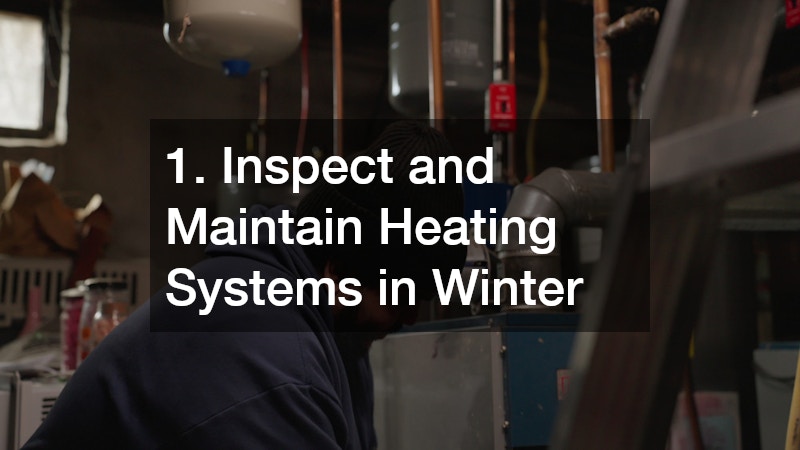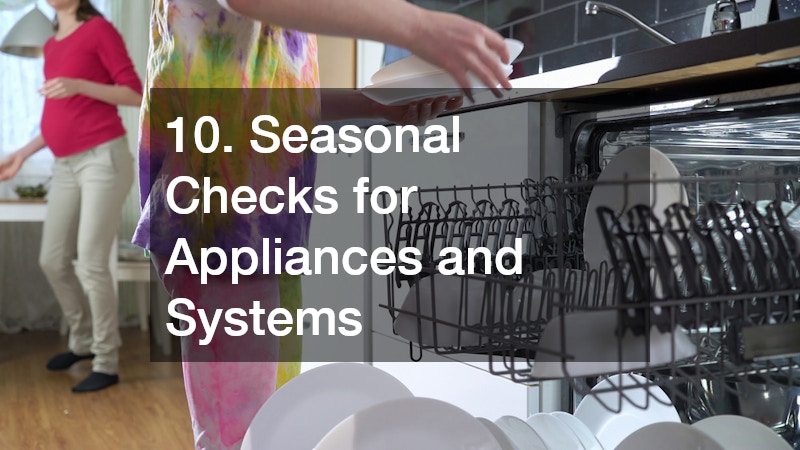Homeownership comes with ongoing responsibilities, and many emergencies can be prevented with regular, seasonal maintenance. Ignoring small issues often leads to costly repairs and significant disruptions, whether it’s a plumbing leak, a failing HVAC system, or structural damage. Homeowners who adopt a proactive approach not only save money but also maintain comfort, safety, and property value.
Seasonal maintenance involves a combination of inspections, minor repairs, and preventative upgrades. Addressing problems before they escalate can reduce stress and avoid unexpected downtime. By following a structured approach and keeping track of key areas in your home, you can ensure everything from heating and cooling systems to structural elements remains in top condition.
This guide outlines ten seasonal maintenance tricks that homeowners can implement throughout the year. Each step focuses on a specific part of the home, highlighting practical solutions, professional services, and preventative actions. Following these tips helps prevent emergencies, keeps living spaces comfortable, and prolongs the life of your home’s essential systems and finishes.
1. Inspect and Maintain Heating Systems in Winter

During the colder months, a well-functioning furnace is critical for both comfort and safety. Scheduling professional furnace maintenance before temperatures drop ensures that heating systems operate efficiently and reliably. Technicians can clean filters, inspect vents, and check for gas leaks or electrical issues that could lead to malfunctions.
Regular maintenance reduces the risk of unexpected breakdowns, which can be costly and inconvenient, especially during severe weather. A maintained furnace also operates more efficiently, lowering energy bills and reducing wear on the system. Homeowners should also check for drafts around windows and doors, seal gaps, and ensure proper insulation to complement furnace performance.
By addressing heating issues proactively, families can avoid emergency repairs, improve indoor comfort, and extend the lifespan of their furnace. Scheduling routine checks each winter or late fall is a simple step that pays off with consistent heat and peace of mind throughout the season.
2. Prepare Cooling Systems for Summer
As temperatures rise, air conditioning becomes essential not only for comfort but also for maintaining healthy indoor air quality. Routine AC repairs and professional inspections before the start of summer ensure that cooling systems operate efficiently when demand is highest. During these checkups, technicians evaluate refrigerant levels, clean coils, inspect electrical components, and test overall system performance to prevent breakdowns and maintain optimal functionality.
Neglecting seasonal AC maintenance can result in overheating, reduced airflow, uneven cooling, and unexpected system failures, often occurring during the hottest days when reliable performance is critical. In addition to preventing emergencies, routine care improves energy efficiency, helping homeowners save on utility costs while extending the lifespan of the equipment. Simple measures—such as replacing air filters, keeping vents and registers clear, and monitoring thermostat settings—can complement professional service and contribute to consistent performance.
Proactive preparation of cooling systems also minimizes stress and prevents uncomfortable or unsafe indoor conditions. A well-maintained air conditioner provides even temperature distribution, better humidity control, and improved indoor air quality, reducing allergens and dust. Regular upkeep lowers the frequency of emergency service calls and keeps the home environment comfortable for all occupants.
3. Inspect Electrical Systems
Seasonal checks of your home’s electrical system are crucial for safety and reliability. Hiring professional residential electricans ensures that circuits, outlets, and wiring are functioning correctly and free from hazards. Electrical issues, if left unaddressed, can lead to outages or dangerous situations such as shocks and fires.
During inspections, electricians can identify frayed wires, overloaded circuits, and other potential problems before they escalate. Seasonal checks also include testing smoke and carbon monoxide detectors, which protect families and property year-round. Proactive maintenance reduces downtime, prevents emergencies, and provides peace of mind.
Keeping electrical systems in top condition allows homeowners to safely operate appliances, heating and cooling systems, and lighting without interruption. Partnering with qualified professionals ensures that inspections and repairs meet safety codes and regulations, safeguarding your home through every season.
4. Clear Plumbing and Drains Year-Round

Clogged pipes and slow drainage can quickly escalate into water damage or backups. Regularly checking for a clogged drain and cleaning it before issues arise prevents costly emergencies. This includes kitchen sinks, bathroom drains, and outdoor drainage systems that can accumulate debris or sediment.
Proactive attention to plumbing involves inspecting pipes for leaks, corrosion, or loose fittings. Seasonal maintenance may also include flushing water heaters, inspecting sump pumps, and ensuring proper drainage around the property. Homeowners can complement professional service with basic cleaning and monitoring to prevent small problems from turning into major repairs.
Preventing clogs reduces the risk of water damage, mold growth, and foul odors while maintaining smooth water flow. Routine care ensures that plumbing systems remain functional year-round, reducing emergency repair costs and minimizing disruption to daily life.
5. Check Roof and Exterior
Your home’s exterior, including the roof and siding, serves as the first line of defense against weather, pests, and other environmental hazards. Regular seasonal inspections by local roof repair specialists help identify potential issues such as leaks, damaged or missing shingles, cracked flashing, or weakened underlayment. Addressing these problems early prevents water infiltration, structural damage, and expensive emergency repairs that often occur after storms or prolonged exposure to harsh conditions.
In addition to the roof, maintaining siding services is essential for keeping walls sealed and protected from moisture, pests, and temperature extremes. Routine cleaning, repainting, or sealing helps preserve the integrity and appearance of materials, prolonging their lifespan and reducing long-term maintenance costs. Homeowners should also inspect and maintain gutters, downspouts, and flashing to ensure proper water drainage away from the foundation, preventing soil erosion and basement flooding.
Proactive care of exterior elements not only reduces the likelihood of costly emergency repairs but also preserves the overall structural integrity and aesthetic appeal of the home. Maintaining these systems contributes to energy efficiency, enhances curb appeal, and protects the value of the property. By incorporating seasonal inspections and upkeep into a regular maintenance routine, homeowners can enjoy peace of mind, knowing their home is well-protected and resilient against the challenges of each season.
6. Maintain Flooring and Surfaces Seasonally

Seasonal maintenance of flooring and surfaces is essential for preserving both the appearance and durability of your home’s interior. Changes in temperature and humidity throughout the year can cause wood flooring to expand or contract, leading to gaps, warping, or cracks if left unchecked. Performing inspections at the start of each season allows homeowners to identify early signs of damage, such as scratches, loose planks, or moisture-related issues, and address them before they worsen.
Similarly, countertops benefit from seasonal attention. Fluctuations in humidity and temperature, combined with daily wear and tear, can lead to stains, chips, or small cracks. Seasonal checks provide the opportunity to clean surfaces thoroughly, apply protective treatments, and repair minor damage, helping to extend the lifespan of these high-use areas.
Preventive care also includes adjusting for seasonal factors like wet shoes in winter, increased sunlight exposure in summer, or humidity shifts in spring and fall. Implementing protective measures—such as area rugs, mats, or sealants—reduces the risk of long-term wear. Regular inspections and maintenance help homeowners address minor issues promptly, avoiding costly repairs or replacements later.
7. Inspect HVAC and Ductwork
Heating, ventilation, and air conditioning systems benefit from seasonal inspections and cleaning. Ensuring airflow and proper function prevents strain on the system, reduces energy costs, and maintains indoor air quality. Technicians can identify leaks, worn components, or blockages in ductwork before they impact performance.
Regular maintenance also includes checking thermostats, vents, and filters, which improves efficiency and prolongs system life. Preventive inspections reduce the likelihood of emergency repairs during peak heating or cooling seasons, ensuring consistent comfort throughout the year.
Proactive care of HVAC systems is a small investment that prevents major malfunctions, enhances efficiency, and supports a healthier indoor environment for residents.
8. Inspect Septic and Plumbing Systems
For homes with septic systems, seasonal checks are vital to prevent backups or contamination. Septic repairs may be necessary if tanks are full, pipes are clogged, or leach fields are compromised. Routine inspections identify these issues early, protecting the home and the surrounding environment.
Homeowners should also examine plumbing connections, valves, and pumps to ensure smooth operation. Catching minor leaks, clogs, or blockages early prevents costly water damage, system failure, and the inconvenience of emergency plumbing service.
Proactive septic and plumbing maintenance keeps the home safe, functional, and environmentally compliant. Regular attention extends system lifespan and reduces the likelihood of costly, stressful repairs.
9. Evaluate Structural and Exterior Elements
Seasonal attention to structural elements such as foundations, decks, and exterior walls is essential for preventing long-term deterioration and costly repairs. Engaging general contractors for periodic inspections ensures that minor issues—like small cracks, early signs of rot, or uneven settling—are identified and addressed before they escalate. Early intervention can prevent major repairs, including foundation stabilization, extensive wall reconstruction, or full deck replacement, which are far more disruptive and expensive.
In addition to foundations and decks, maintaining fences, patios, and other outdoor structures safeguards both the home’s value and the safety of its occupants. Seasonal upkeep may involve sealing wood surfaces, repairing damaged boards or supports, or reinforcing structures to withstand extreme weather conditions. Regularly checking for signs of pest infestation or water damage also helps prevent further deterioration and preserves structural integrity over time.
Proactive care of these elements allows homeowners to avoid emergencies caused by storms, moisture, pests, or material fatigue. A strong, well-maintained exterior not only provides long-term protection but also enhances curb appeal, property value, and the overall durability of the home. By incorporating these inspections and maintenance tasks into a seasonal routine, homeowners can enjoy peace of mind knowing that both visible and hidden structural components are secure and resilient year-round.
10. Seasonal Checks for Appliances and Systems

Finally, reviewing home appliances and essential systems on a seasonal basis is a crucial step in maintaining a safe, efficient, and reliable household. Kitchens, laundry areas, and utility spaces contain some of the most frequently used equipment in the home, including refrigerators, ovens, dishwashers, washing machines, dryers, water heaters, and HVAC components. Over time, regular use can lead to wear, leaks, or reduced efficiency. By performing seasonal inspections, homeowners can identify early signs of malfunction, preventing minor issues from escalating into costly repairs or total appliance failures.
Routine attention goes beyond simple cleaning. It includes testing appliances, tightening connections, inspecting hoses and seals, and ensuring electrical components are functioning properly. For instance, checking refrigerator door seals helps maintain optimal cooling performance and prevents energy waste, while examining washer and dryer hoses for cracks or loose fittings prevents leaks that could damage flooring or walls. Ventilation systems should also be cleaned and checked to maintain proper airflow, reduce fire hazards, and support efficient heating or cooling. Homeowners can complement these efforts with minor adjustments, such as recalibrating thermostats, cleaning dryer vents, or replacing worn belts in laundry machines.
Integrating appliance checks into a regular maintenance routine provides multiple benefits. It improves energy efficiency, reduces the risk of emergency repairs, and prolongs the lifespan of critical systems. Additionally, proactively maintaining these items ensures consistent performance, helping the household run smoothly and safely throughout the year. Homeowners who stay on top of seasonal inspections create a more comfortable living environment, minimize unexpected downtime, and protect their investment in essential home systems.
Seasonal home maintenance is more than just a chore—it’s a vital strategy for preventing emergencies, lowering repair costs, and preserving your property’s long-term value. Homes face a variety of challenges throughout the year, from harsh winter weather and summer heat to heavy rainfall or springtime storms. Neglecting regular inspections and preventive care can quickly turn minor issues into expensive, time-consuming problems. By focusing on key areas such as heating and cooling systems, plumbing, roofing, flooring, and appliances, homeowners can maintain comfort, safety, and operational efficiency no matter the season.
Creating a structured seasonal maintenance routine transforms homeownership into a more manageable, stress-free process. By scheduling tasks ahead of time and addressing minor issues proactively, you reduce the risk of unexpected breakdowns and emergency repairs. This approach not only protects your financial investment but also ensures your home remains safe, functional, and comfortable for you and your family throughout the year.
